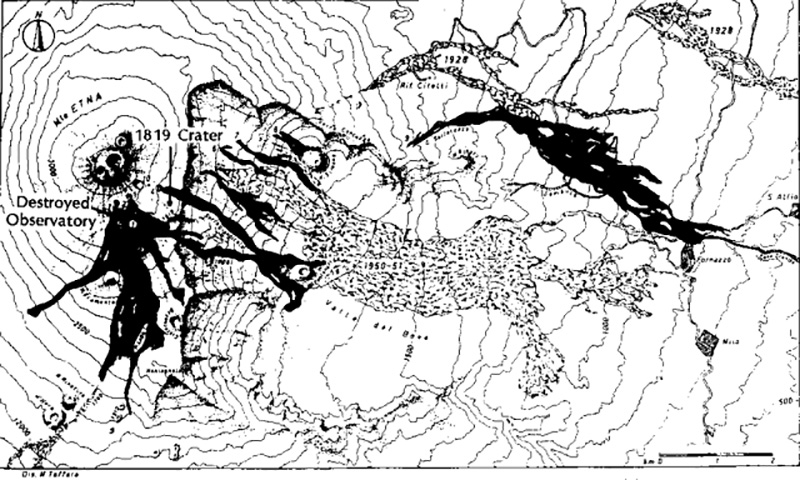Report on Etna (Italy) — April 1978
Scientific Event Alert Network Bulletin, vol. 3, no. 4 (April 1978)
Managing Editor: David Squires.
Etna (Italy) First SE flank activity since 1971
Please cite this report as:
Global Volcanism Program, 1978. Report on Etna (Italy) (Squires, D., ed.). Scientific Event Alert Network Bulletin, 3:4. Smithsonian Institution. https://doi.org/10.5479/si.GVP.SEAN197804-211060
Etna
Italy
37.748°N, 14.999°E; summit elev. 3357 m
All times are local (unless otherwise noted)
An eruption began 29 April and continued as of 3 May. Lava was extruded from four new vents, on the SE flank, and had reached the 1700 m level near Monti Centenari, the 1852 cone by the morning of the 3rd. Explosive activity ejected bombs to 300 m above the largest of the vents (near the 1819 crater; figure 4) and built a 50-m cone. Explosions had declined by early 3 May, but vigorous lava effusion continued.
 |
Figure 4. Map of Mt. Etna, showing 1971 lava flows in black and earlier flows in other patterns. Contour interval, 100 m. From Rittman and others, 1971. |
Frequent brief eruptions from Etna have occurred since July 1977, but all have originated from vents on the Northeast Crater cone. The last SE flank eruption occurred 5 April-12 June, 1971, destroying the Etna Observatory.
Reference. Rittman, A., Romano, R., and Sturiale, C., 1971, L'Eruzione Etnea dell'Aprile-Giugno 1971: Atti della Accademia Gioenia di Scienze Naturali in Catania, Serie Sestima, v.3.
Geological Summary. Mount Etna, towering above Catania on the island of Sicily, has one of the world's longest documented records of volcanism, dating back to 1500 BCE. Historical lava flows of basaltic composition cover much of the surface of this massive volcano, whose edifice is the highest and most voluminous in Italy. The Mongibello stratovolcano, truncated by several small calderas, was constructed during the late Pleistocene and Holocene over an older shield volcano. The most prominent morphological feature of Etna is the Valle del Bove, a 5 x 10 km caldera open to the east. Two styles of eruptive activity typically occur, sometimes simultaneously. Persistent explosive eruptions, sometimes with minor lava emissions, take place from one or more summit craters. Flank vents, typically with higher effusion rates, are less frequently active and originate from fissures that open progressively downward from near the summit (usually accompanied by Strombolian eruptions at the upper end). Cinder cones are commonly constructed over the vents of lower-flank lava flows. Lava flows extend to the foot of the volcano on all sides and have reached the sea over a broad area on the SE flank.
Information Contacts: J. Guest, Univ. of London; R. Romano, IIV.

